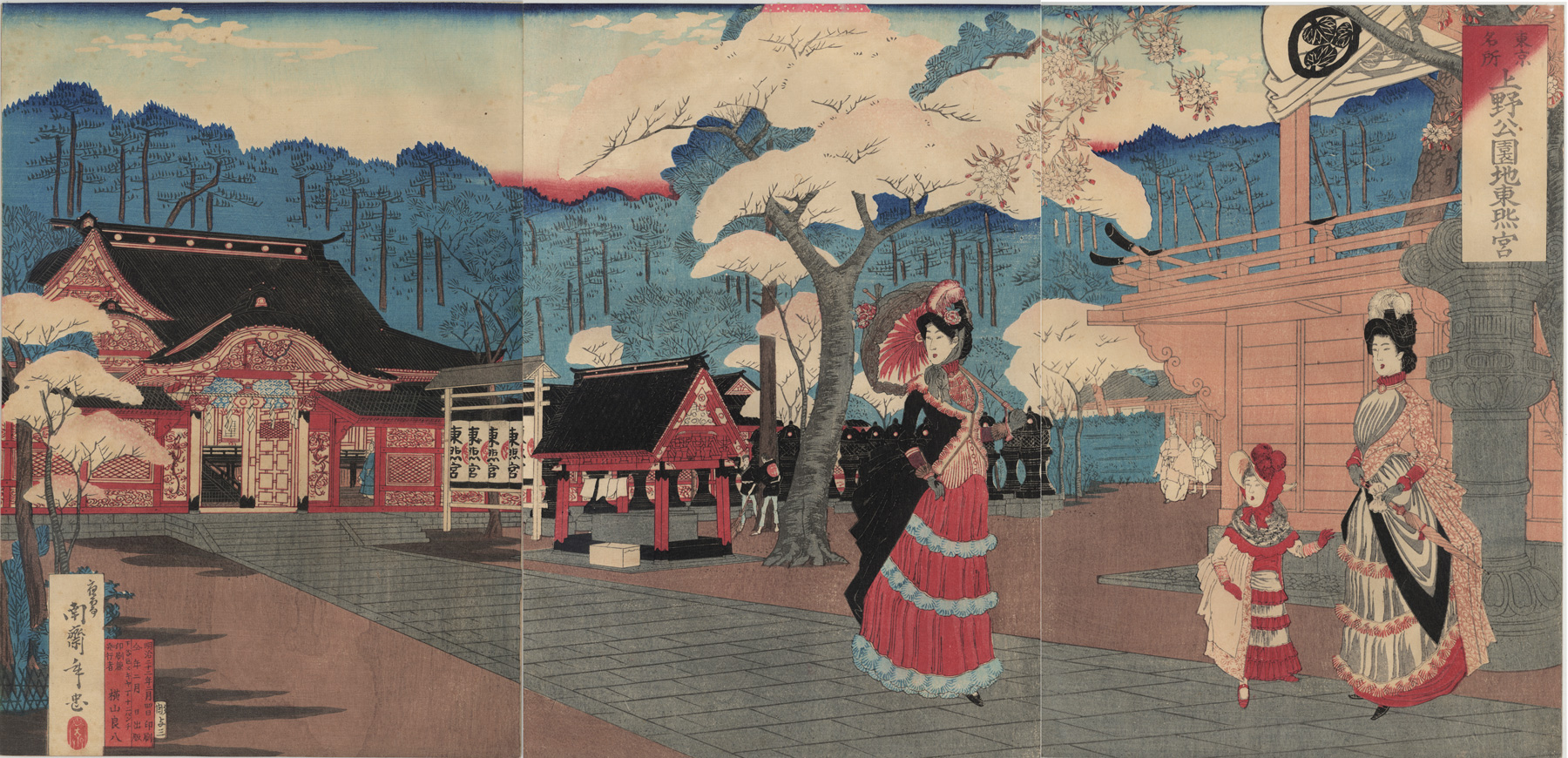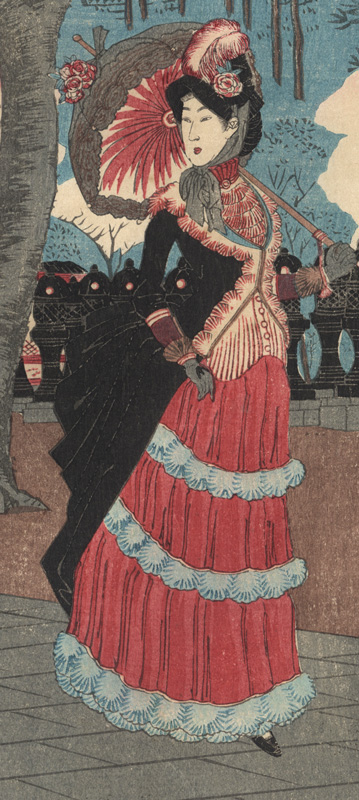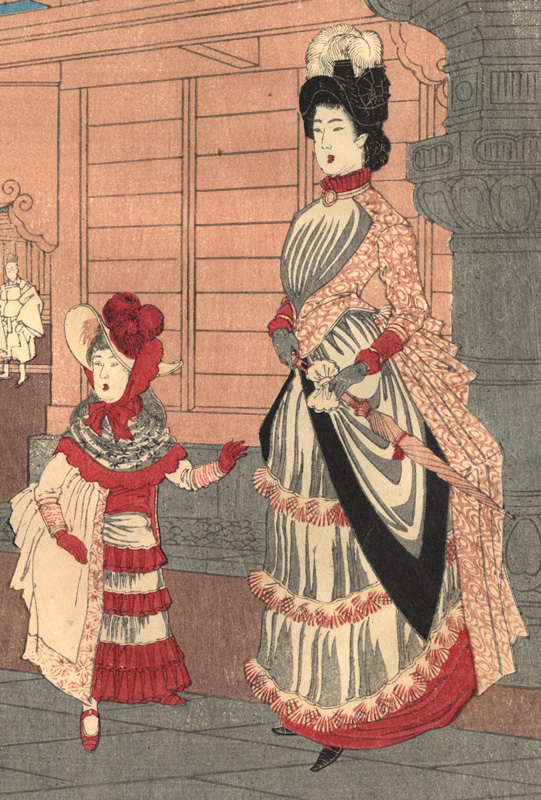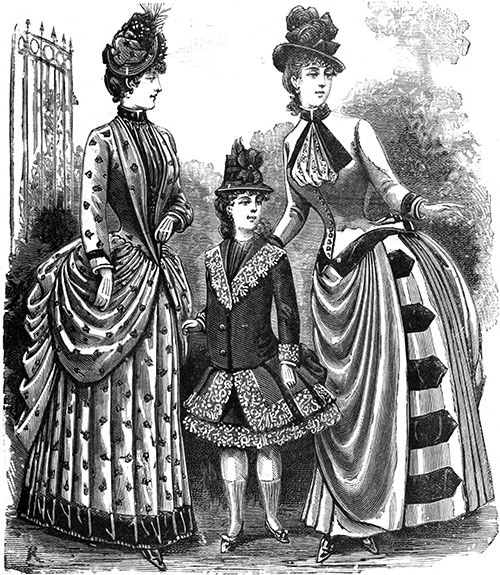About This Print
It is spring and the cherry trees are in bloom as two women and a child all dressed in Western fashion are strolling through Tokyo's Tōshō-gū Shrine. The shrine dedicated to shogun Tokugawa Ieyasu (1543-1616) and founded in 1627, has been spared the many natural and man-caused disasters that have visited Tokyo and today remains largely unchanged from its renovation in 1651. The trio likely entered the grounds through Karamon gate, seen in the left panel. Five small figures, three priests and two groundskeepers, can also be seen. While the print is a "scenic view" of this Tokyo landmark, the real scenic view is the high-fashion Western dress of the women and child.Western dress for women of a certain class was kicked-off by the empress in 1886 when she "decided that a consort to a modern emperor needed to dress in the modern, i.e., Western mode," and went on to require Western dress at the court and at public events for her ladies-in-waiting, the imperial princesses, government employees (e.g. teachers) and the wives of officials.1
The empress's proclamation issued in January 1887 advising all women to adopt Western fashion became "no small burden" for the women effected as pointed out by Miriam Wattles of University of California, Santa Barbara.
While Western dress was still in fashion in 1889 when this print was produced, "by the 1890s, most women were again wearing kimono, reinventing as fashion does, the traditional styles of times past."3
1887-88, the years when Westernized fashion in Japan were at a height, were the pinnacle of fashion for the bustle. Thus, these ladies had to not only take on the weight of copious layers of fabric, but also distort their figures into the unnatural shape dictated by the bustle. Additionally, even though dresses could be ordered from both native and foreign dress designers in Tokyo, it was difficult to afford for many of the public servants required to wear them.2
1885 London fashion |
Whether this print was commissioned by one of the Tokyo stores selling Western women's clothes or one of the sewing shops to advertise their expertise in creating Western garb is unknown.
1 "Gender, Citizenship and Dress in Modernizing Japan," Barbara Molony appearing in The Politics of Dress in Asia and the Americas, ed. Mina Roces and Louise Edwards, Sussex Academic Press, 2008, p. 90
2 University of British Columbia website https://meijiat150dtr.arts.ubc.ca/essays/wattles/
3 ibid.
4 Victoria and Albert Museum website http://www.vam.ac.uk/content/articles/h/history-of-fashion-1840-1900/
Print Details
| IHL Catalog | #2008 |
| Title | Scenic View of Tokyo, Ueno Park Tōshō-gū Shrine 東京名所上野公園地東照宮 Tōkyō meisho Ueno kōenchi Tōshō gū |
| Artist | Yamada Toshitada (1868-1934) |
| Signature |  |
| Seal | unread seal (as shown above) |
| Publication Date |  明治ニ十ニ年ニ月 日 出版 published: February 1889 (as shown below in publisher's seal) 明治ニ十ニ年ニ月四日 印刷 printing: February 4, 1889 (as shown below in publisher's seal) |
| Publisher |  印刷兼発行者 橫山良八 printer and publisher: Yokoyama Ryōhachi [Marks: pub. ref. 623; seal not shown] |
| Carver | 彫?三  |
| Impression | excellent |
| Colors | excellent |
| Condition | good - three sheets joined; trimmed to image; soiling upper part of left and center sheets |
| Genre | ukiyo-e; meisho-e; kaika-e |
| Miscellaneous | |
| Format | vertical oban triptych |
| H x W Paper | 13 9/16 x 28 in. (34.4 x 71.1 cm) |
| Literature | |
| Collections This Print |
1/21/2020 created





